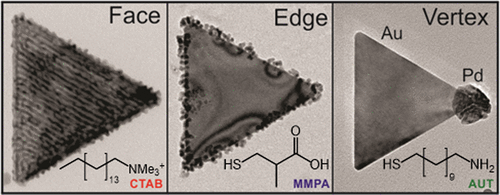Our official English website, www.x-mol.net, welcomes your feedback! (Note: you will need to create a separate account there.)
Ligand-Mediated Deposition of Noble Metals at Nanoparticle Plasmonic Hotspots
Langmuir ( IF 3.9 ) Pub Date : 2017-11-17 00:00:00 , DOI: 10.1021/acs.langmuir.7b03309 Patrick J. Straney 1 , Nathan A. Diemler 1 , Ashley M. Smith 1 , Zachary E. Eddinger 1 , Matthew S. Gilliam 1 , Jill E. Millstone 1
Langmuir ( IF 3.9 ) Pub Date : 2017-11-17 00:00:00 , DOI: 10.1021/acs.langmuir.7b03309 Patrick J. Straney 1 , Nathan A. Diemler 1 , Ashley M. Smith 1 , Zachary E. Eddinger 1 , Matthew S. Gilliam 1 , Jill E. Millstone 1
Affiliation

|
We report the use of gold nanoparticle surface chemistry as a tool for site-selective noble metal deposition onto colloidal gold nanoparticle substrates. Specifically, we demonstrate that partial passivation of the gold nanoparticle surface using thiolated ligands can induce a transition from linear palladium island deposition to growth of palladium selectively at plasmonic hotspots on the edges or vertices of the underlying particle substrate. Further, we demonstrate the broader applicability of this approach with respect to substrate morphology (e.g., prismatic and rod-shaped nanoparticles), secondary metal (e.g., palladium, gold, and platinum), and surface ligand (e.g., surfactant molecules and n-alkanethiols). Taken together, these results demonstrate the important role of metal–ligand surface chemistry and ligand packing density on the resulting modes of multimetallic nanoparticle growth, and in particular, the ability to direct that growth to particle regions of impact such as plasmonic hotspots.
中文翻译:

纳米粒子等离子热点的配体介导的贵金属沉积
我们报告了金纳米粒子表面化学的使用,作为在胶体金纳米粒子基质上进行位置选择性贵金属沉积的工具。具体而言,我们证明了使用硫醇化配体对金纳米颗粒表面进行部分钝化可以诱导从线性钯岛沉积向钯生长的过渡,该沉积是在底层颗粒基质的边缘或顶点上的等离激元热点处选择性地进行的。此外,我们证明了这种方法在基材形态(例如棱柱形和棒状纳米颗粒),仲金属(例如钯,金和铂)和表面配体(例如表面活性剂分子和n-链烷硫醇)。综上所述,这些结果证明了金属-配体的表面化学和配体堆积密度在最终的多金属纳米颗粒生长方式中的重要作用,尤其是将这种生长定向到撞击等离子区域的能力。
更新日期:2017-11-17
中文翻译:

纳米粒子等离子热点的配体介导的贵金属沉积
我们报告了金纳米粒子表面化学的使用,作为在胶体金纳米粒子基质上进行位置选择性贵金属沉积的工具。具体而言,我们证明了使用硫醇化配体对金纳米颗粒表面进行部分钝化可以诱导从线性钯岛沉积向钯生长的过渡,该沉积是在底层颗粒基质的边缘或顶点上的等离激元热点处选择性地进行的。此外,我们证明了这种方法在基材形态(例如棱柱形和棒状纳米颗粒),仲金属(例如钯,金和铂)和表面配体(例如表面活性剂分子和n-链烷硫醇)。综上所述,这些结果证明了金属-配体的表面化学和配体堆积密度在最终的多金属纳米颗粒生长方式中的重要作用,尤其是将这种生长定向到撞击等离子区域的能力。



























 京公网安备 11010802027423号
京公网安备 11010802027423号